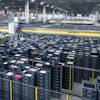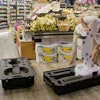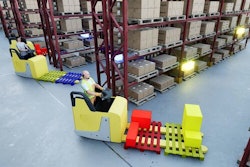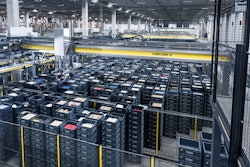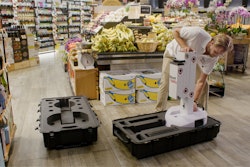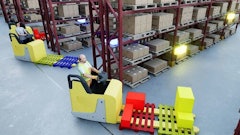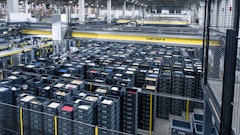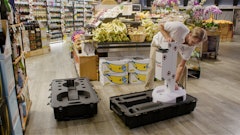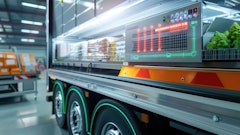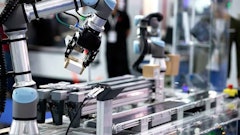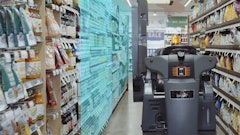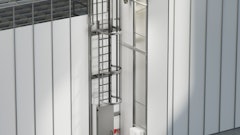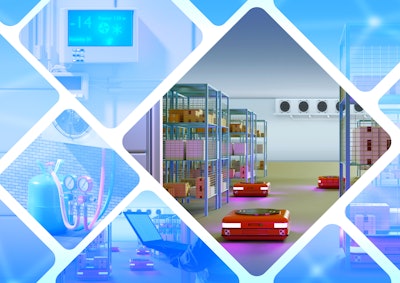
Across the retail industry, from general merchandise to apparel, automation is increasingly synonymous with the fulfillment operations that ensure store shelves are fully stocked and online customers receive accurate, on-time orders. The warehouses and the distribution centers that make this possible are as varied as the brands they serve, ranging from state-of-the-art facilities purpose-built with advanced materials handling technology and robotics, to older warehouses retrofitted to meet modern demands.
Whether they represent the very leading edge of innovation or rely on predominantly manual processes augmented with new technologies, one thing is certain: no sector demands more from its operations than grocery and food. The grocery supply chain and fulfillment process is a marvel of efficiency and resilience.
From a sheer frequency and volume perspective, grocers and their supporting distributors are in a league all their own. Demand never really slows – at least not in the way it does in other retail sectors. The universal daily need for food demands that operations are up and running every hour, every day, year-round.
Adding to this “always on” reality is the very nature of the products involved. Temperature-sensitive goods and the cold chain handling they require adds an element of complexity encountered nowhere else. The very idea of product spoilage, a constant concern in distributors’ and grocers’ operations, is virtually unknown in other sectors.
Further intensifying these challenges is the growing demand driven by the rise in online grocery shopping. As more consumers turn to digital options, the food supply chain becomes increasingly complex. In fact, a recent survey showed that online grocery sales reached a new record of $11.2 billion in August 2025, marking a nearly 14% year-over-year increase.
Then there is the overt price sensitivity that differentiates groceries. No other sector works within the constraints of thinner margins – a direct reflection of the fact that consumers are inherently price-sensitive when it comes to food and beverages.
Peak shopping periods add to these realities, but grocers and food distributors face different challenges. While most retailers face changing demands throughout the year, with the holiday shopping season still exerting a significant impact on profitability, grocers and food distributors face multiple peak seasons of varying impact, from the holiday season to the Fourth of July.
To thrive in the face of these demands year-round, it requires grocers and distributors to be more efficient and effective than ever. For many, this means greater use and reliance on robotics and automation. While both are integral to fulfillment and store replenishment processes, maximizing their impact on peak season flexibility and daily performance requires leaders to keep several important considerations in mind.
Take steps to optimize the use of automation and robotics for greater flexibility
Regardless of whether you are fine-tuning an existing distribution, store replenishment and fulfillment operation, or looking to add greater efficiency to peak season business with new robotics, several considerations and corresponding steps are broadly applicable. These can be applied not only to long-term optimization efforts, but also the gathering of operational intelligence during the upcoming holiday peak season.
- Examine current processes: Every application of technology for greater flexibility begins with questions. Introspection should be a constant endeavor. Questions such as "Where is efficiency being lost?", "Where is the most variability in my operation?" and "What tasks take the most time?" should be continually explored.
In most operations, the greatest variability centers around people, whether it’s a shortage of available new hires or changes in performance due to factors like illness or even a poor night’s sleep. Tasks that typically take the most time are often those that require the most movement of people. For example, 70% of employees’ time in manual warehouses is spent walking to retrieve items.
Another area that tends to be the most time-consuming is building pallets for shipment and breaking them down once they arrive at the store to be stocked on shelves. Fortunately, automation such as advanced automated storage and retrieval systems (AS/RS), automated guided vehicles (AGVs), robotics pickers, and palletizing and depalletizing robots are all proven and effective ways to do these tasks faster. Additionally, advanced software enables pallets to be built with each store’s unique floor layout in mind, enabling them to be placed in the correct aisle and eliminating the need to break down pallets and sort them altogether.
2. Analyze a treasure trove of data: Facilities should not be designed to address peak demands, but rather to balance them with day-to-day demands in a sustainable manner. For instance, by implementing a right-sized automated distribution and warehouse process, grocers can efficiently manage peak seasons by adding a small number of seasonal employees or offering extra hours to existing staff.
Right-sizing begins with a thorough analysis of data. What is being shipped, and at what volume throughout the year? Which items are the fastest movers?
Grocers and distributors should look at SKU-level data to gain a clear understanding of the seasonality of products and where spoilage occurred. This insight can then help determine where technology can be applied. For example, automated mobile robots can handle highly repetitive tasks with high employee turnover, such as moving cartons from the loading dock to storage areas. Additionally, advanced software can track perishable items like meat and dairy more effectively, coordinating with robots to ensure timely movement and eliminate spoilage.
3. Approach automation in a modular fashion: While the ideal future state may be a greenfield facility that uses the most advanced robotics and automation, that is not always feasible, or even desirable, for every organization. A more modular approach offers a flexible alternative. By focusing on the most labor-intensive or time-consuming tasks, organizations handling goods can implement targeted technologies that streamline operations and save time. This approach often requires a limited capital investment, making it a broadly applicable and cost-effective solution.
Practical automation is better than no automation. For instance, a distributor whose facility cannot accommodate a shuttle-based AS/RS – whether due to layout constraints, high costs, or lengthy deployment timelines – might find greater value in an automated case handling mobile robot (ACR). While ACRs may deliver lower throughput compared to AS/RS, they can leverage existing racking systems and still provide significantly faster item retrieval and increased storage capacity compared to slower, labor-intensive manual methods.
4. Always consider the needs of people: The effective use of automation in the grocery sector is marked by a single characteristic – it benefits warehouse and distribution center employees. Ergonomics should always be a key concern. Even slight changes, such as using robotic pickers to handle most orders and ensuring manually-picked items only need to be slid rather than lifted, can dramatically improve efficiency and throughout. At the same time, these improvements ensure that employees are happier and healthier.
5. Think long-term: While the cost of labor continues to increase, the cost of automation and robotics that can take on many of the most demanding tasks continues to decrease. For grocers and distributors looking to modernize their systems and processes – whether to manage peak seasons or optimize daily operations – it’s essential to evaluate all available options.
Robots-as-a-service and similar solutions can significantly transform warehouse and fulfillment operations, often being deployed in just days. On the other end of the spectrum, designing and constructing new facilities with advanced systems can unlock substantial business opportunities but may take up to two years to complete. When planning for the future, technology and service providers should present detailed business cases for each solution, highlighting the wide range of possibilities to meet operational needs and goals.
By keeping these considerations in mind, those in the food supply chain can thrive each and every day. With the right robotics and automation in place, even peak times can be business as usual.


